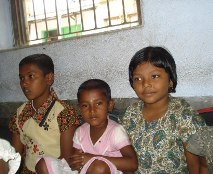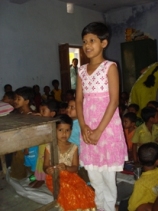Bangladesh: From the streets to the classrooms

UNODC recently visited one of the remote provinces in the border of West Bengal and Bangladesh to learn about community initiatives to address trafficking of children and girls. Here is a story on a primary school initiative which promotes healthy lives, provides quality education and protects children from abuse, exploitation and violence.
Six days a week, ten year old Anima*, treks the one kilometre to the only primary school in her village, in the border area of Bangladesh. She walks barefoot with a torn satchel slung over her shoulders. Her father breaks stones in a nearby quarry while her mother works in the paddy fields. These days her little five year old sister accompanies her as well. Braving the scorching heat, the stone-filled roads and dust, they reach their school. The classroom is tiny and there are only 2 windows, an old table, chair and a makeshift blackboard. Around 100 eager children aged 5 to 12 attend class in this one room. Attending school may be an ordinary scene in urban cities, but in this remote village, this is a remarkable feat.
The children sit on the floor, books open in laps and listen to the senior headmaster from Kolkata, India. He dedicates all his
 time in helping the children not only stay in school and complete their education, but most importantly raises their awareness on prevention of human trafficking, why it occurs, its cause, who are the potential victims and how to take preventive steps.
time in helping the children not only stay in school and complete their education, but most importantly raises their awareness on prevention of human trafficking, why it occurs, its cause, who are the potential victims and how to take preventive steps.
The headmaster shares, "there have been several reported cases in this village, where girls as young as 5 years have been trafficked or sold by families. They become victims of sexual and labour exploitation in West Bengal. Approximately seven thousand girls and women are trafficked from Bangladesh to West Bengal annually. It is a harsh world for these innocent children. They may be too young to learn about such issues but it is essential, if we are to stop this crime. They are the potential victims and we must educate them at the earliest."
 Anima is the head girl of the class. Standing tall in front of her classmates, she urges them to recite in chorus a short poem in the local language. The poem centres around the heinous crime of human trafficking and how children are vulnerable, but not helpless to act. In addition, Anima explains to the class, "we should refuse to speak to strangers especially men. If he offers us sweets and lures us with tales of good life, we should report this to our elders or the police. Traffickers lure children like us. We are sold to brothels, sexually exploited and abused. We are forced to work in houses and factories with no food and no money. This is not what we want. We want to be educated and aware." The room fills up with claps.
Anima is the head girl of the class. Standing tall in front of her classmates, she urges them to recite in chorus a short poem in the local language. The poem centres around the heinous crime of human trafficking and how children are vulnerable, but not helpless to act. In addition, Anima explains to the class, "we should refuse to speak to strangers especially men. If he offers us sweets and lures us with tales of good life, we should report this to our elders or the police. Traffickers lure children like us. We are sold to brothels, sexually exploited and abused. We are forced to work in houses and factories with no food and no money. This is not what we want. We want to be educated and aware." The room fills up with claps.
"The children are always the best teachers!" exclaims the headmaster. He believes they are in a great position to help spread information on these issues and raise the awareness of the whole community.
Such initiatives, where life-saving messages are built into the education curricula, help children grow safely and wisely in a world fraught with danger.
UNODC with ATSEC India (Action Against Trafficking and Sexual Exploitation of Children) a network of NGOs working on prevention of human trafficking, supports this initiative under the UNODC project on prevention of human trafficking. This initiative is possible thanks to the contribution of the United States Agency for International Development (USAID).
*Name changed